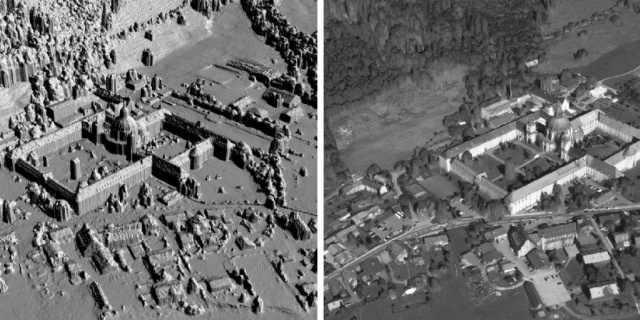上一篇看了较为简单的BM算法,后面又看了下opencv里的SGBM算法。之所以叫SGBM是因为opencv并没有使用MI作为匹配代价,而是仍然使用了块匹配的方法,相关cost的度量为Birchfield-Tomasi metric。而且opencv提供了多种cost aggregation的方式,包括只使用3个、5个或全部8个方向的方法。总体上的实现也比较直观,结合论文也比较好懂。
对于理论就不再赘述了,需要的话可以直接参考我之前的文章
David LEE:一文读懂经典双目稠密匹配算法SGMzhuanlan.zhihu.com
这里就直接探讨opencv中关于SGBM的源代码。
/*
computes disparity for "roi" in img1 w.r.t. img2 and write it to disp1buf.
that is, disp1buf(x, y)=d means that img1(x+roi.x, y+roi.y) ~ img2(x+roi.x-d, y+roi.y).
minD <= d < maxD.
disp2full is the reverse disparity map, that is:
disp2full(x+roi.x,y+roi.y)=d means that img2(x+roi.x, y+roi.y) ~ img1(x+roi.x+d, y+roi.y)
note that disp1buf will have the same size as the roi and
disp2full will have the same size as img1 (or img2).
On exit disp2buf is not the final disparity, it is an intermediate result that becomes
final after all the tiles are processed.
the disparity in disp1buf is written with sub-pixel accuracy
(4 fractional bits, see StereoSGBM::DISP_SCALE),
using quadratic interpolation, while the disparity in disp2buf
is written as is, without interpolation.
disp2cost also has the same size as img1 (or img2).
It contains the minimum current cost, used to find the best disparity, corresponding to the minimal cost.
*/
static void computeDisparitySGBM( const Mat& img1, const Mat& img2,
Mat& disp1, const StereoSGBMParams& params,
Mat& buffer )
{
const int ALIGN = 16;
const int DISP_SHIFT = StereoMatcher::DISP_SHIFT;
const int DISP_SCALE = (1 << DISP_SHIFT);
const CostType MAX_COST = SHRT_MAX;
int minD = params.minDisparity, maxD = minD + params.numDisparities;
Size SADWindowSize;
SADWindowSize.width = SADWindowSize.height = params.SADWindowSize > 0 ? params.SADWindowSize : 5;
int ftzero = std::max(params.preFilterCap, 15) | 1;
int uniquenessRatio = params.uniquenessRatio >= 0 ? params.uniquenessRatio : 10;
int disp12MaxDiff = params.disp12MaxDiff > 0 ? params.disp12MaxDiff : 1; // consisit check 所允许的最大差异
int P1 = params.P1 > 0 ? params.P1 : 2, P2 = std::max(params.P2 > 0 ? params.P2 : 5, P1+1);
int k, width = disp1.cols, height = disp1.rows;
int minX1 = std::max(maxD, 0), maxX1 = width + std::min(minD, 0);
int D = maxD - minD, width1 = maxX1 - minX1; // 视差值的有效搜索范围
int INVALID_DISP = minD - 1, INVALID_DISP_SCALED = INVALID_DISP*DISP_SCALE;
int SW2 = SADWindowSize.width/2, SH2 = SADWindowSize.height/2;
bool fullDP = params.mode == StereoSGBM::MODE_HH;
int npasses = fullDP ? 2 : 1;
const int TAB_OFS = 256*4, TAB_SIZE = 256 + TAB_OFS*2;
PixType clipTab[TAB_SIZE];
// 同stereoBM, xsobel索引表
for( k = 0; k < TAB_SIZE; k++ )
clipTab[k] = (PixType)(std::min(std::max(k - TAB_OFS, -ftzero), ftzero) + ftzero);
if( minX1 >= maxX1 )
{
disp1 = Scalar::all(INVALID_DISP_SCALED);
return;
}
CV_Assert( D % 16 == 0 );
// NR - the number of directions. the loop on x below that computes Lr assumes that NR == 8.
// if you change NR, please, modify the loop as well.
int D2 = D+16, NRD2 = NR2*D2;
// the number of L_r(.,.) and min_k L_r(.,.) lines in the buffer:
// for 8-way dynamic programming we need the current row and
// the previous row, i.e. 2 rows in total
const int NLR = 2;
const int LrBorder = NLR - 1;
// for each possible stereo match (img1(x,y) <=> img2(x-d,y))
// we keep pixel difference cost (C) and the summary cost over NR directions (S).
// we also keep all the partial costs for the previous line L_r(x,d) and also min_k L_r(x, k)
size_t costBufSize = width1*D;
size_t CSBufSize = costBufSize*(fullDP ? height : 1); // cost aggregation 采用8个方向的话则需要WHD大小的内存
size_t minLrSize = (width1 + LrBorder*2)*NR2, LrSize = minLrSize*D2; // minLr 存储最优视差对应的最小cost,大小为有效宽度(再加2)乘以8个方向
// Lr 在此基础上需要存储160个视差值所对应的全部cost。
// DP 算法每次只用到上一行或下一行的信息,因此只保留两行的数据,最后乘以NR2
int hsumBufNRows = SH2*2 + 2; // 一个匹配窗口所包含的行数再加1,方便滑动窗口法每次多算一行
size_t totalBufSize = (LrSize + minLrSize)*NLR*sizeof(CostType) + // minLr[] and Lr[]
costBufSize*(hsumBufNRows + 1)*sizeof(CostType) + // hsumBuf, pixdiff // costBufSize * 1 是pixeldiff的内存大小,一行各个像素的所有可能视差值对应的cost
// costBufSize * hsumBufNRows 是hsumBuf的内存大小,滑动窗口内各行的像素对应的所有视差值的cost
CSBufSize*2*sizeof(CostType) + // C, S // C 和S 都需要保存WHD个计算结果
width*16*img1.channels()*sizeof(PixType) + // temp buffer for computing per-pixel cost
width*(sizeof(CostType) + sizeof(DispType)) + 1024; // disp2cost + disp2
if( buffer.empty() || !buffer.isContinuous() ||
buffer.cols*buffer.rows*buffer.elemSize() < totalBufSize )
buffer.reserveBuffer(totalBufSize);
// summary cost over different (nDirs) directions
CostType* Cbuf = (CostType*)alignPtr(buffer.ptr(), ALIGN); // C
CostType* Sbuf = Cbuf + CSBufSize; // S
CostType* hsumBuf = Sbuf + CSBufSize;
CostType* pixDiff = hsumBuf + costBufSize*hsumBufNRows;
CostType* disp2cost = pixDiff + costBufSize + (LrSize + minLrSize)*NLR; // 预留给hsumBuf, Lr[]和minLr[]
DispType* disp2ptr = (DispType*)(disp2cost + width);
PixType* tempBuf = (PixType*)(disp2ptr + width);
// add P2 to every C(x,y). it saves a few operations in the inner loops
for(k = 0; k < (int)CSBufSize; k++ )
Cbuf[k] = (CostType)P2;
for( int pass = 1; pass <= npasses; pass++ )
{
int x1, y1, x2, y2, dx, dy;
if( pass == 1 ) // 正向遍历,先计算正向遍历可以计算的4个方向的Lr和minLr,并保存结果在C和S中
{
y1 = 0; y2 = height; dy = 1;
x1 = 0; x2 = width1; dx = 1;
}
else // 逆序遍历
{
y1 = height-1; y2 = -1; dy = -1;
x1 = width1-1; x2 = -1; dx = -1;
}
// 处理方向变化时重新分配指针
CostType *Lr[NLR]={
0}, *minLr[NLR]={
0};
for( k = 0; k < NLR; k++ )
{
// shift Lr[k] and minLr[k] pointers, because we allocated them with the borders,
// and will occasionally use negative indices with the arrays
// we need to shift Lr[k] pointers by 1, to give the space for d=-1.
// however, then the alignment will be imperfect, i.e. bad for SSE,
// thus we shift the pointers by 8 (8*sizeof(short) == 16 - ideal alignment)
Lr[k] = pixDiff + costBufSize + LrSize*k + NRD2*LrBorder + 8;
// 8是为了sse优化,NRD2 * Lr






 本文主要分析了OpenCV中的SGBM算法,它基于Birchfield-Tomasi metric计算cost,并提供了不同方向的成本聚合方式。除了介绍算法原理,还探讨了calcPixelCostBT函数以及视差图后处理滤波函数filterSpeckles,该函数用于去除视差图中的无效区域和飞点,以得到干净的深度图。
本文主要分析了OpenCV中的SGBM算法,它基于Birchfield-Tomasi metric计算cost,并提供了不同方向的成本聚合方式。除了介绍算法原理,还探讨了calcPixelCostBT函数以及视差图后处理滤波函数filterSpeckles,该函数用于去除视差图中的无效区域和飞点,以得到干净的深度图。
 最低0.47元/天 解锁文章
最低0.47元/天 解锁文章















 1535
1535

 被折叠的 条评论
为什么被折叠?
被折叠的 条评论
为什么被折叠?








